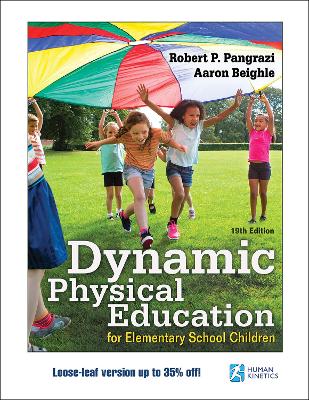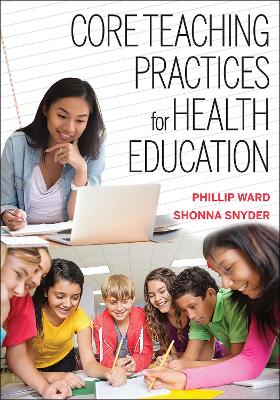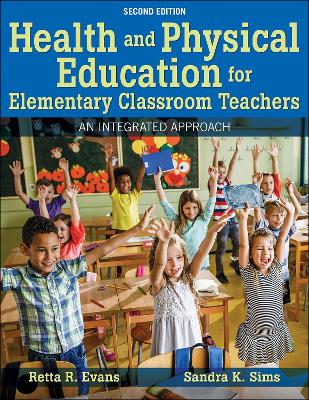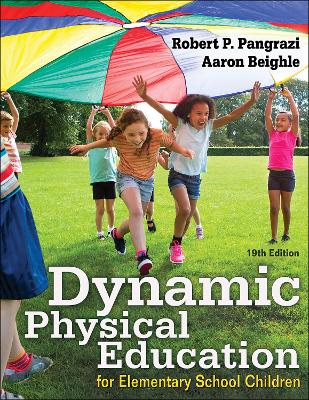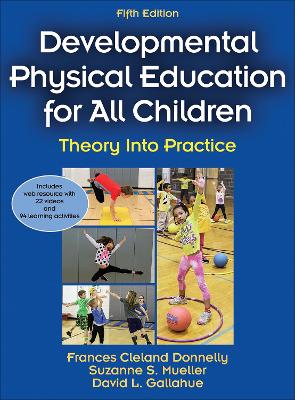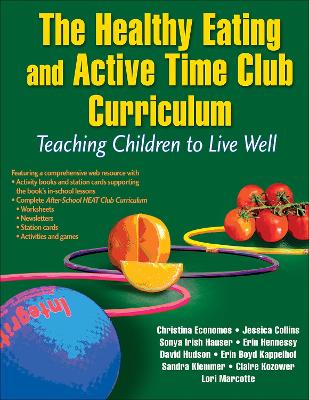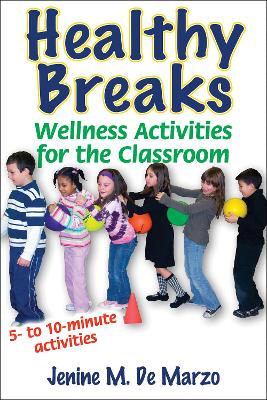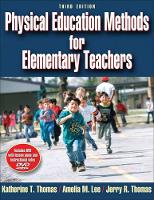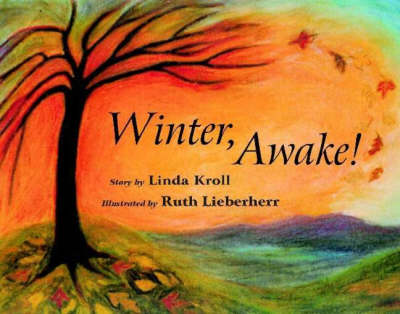Dynamic Physical Education for Elementary School Children
Dynamic Physical Education for Elementary School Children
Pangrazi, Robert P.; Beighle, Aaron
Human Kinetics Publishers
11/2019
760
Loose-leaf
Inglês
9781492592280
2041
Chapter 1. Elementary School Physical Education
What Is Physical Education?
Essential Components of a Quality Physical Education Program
Current Status of Physical Education in the United States
Need for Physical Education Programs
Physical Educators Promoting Physical Activity
Content of Physical Education
SHAPE America National Standards for Physical Literacy
Evolution of Elementary School Physical Education
Learning Aids
Chapter 2. Growth and Development
Physical Growth and Development
Helping Children Find Success in Physical Activity
Safety Guidelines for Physical Activity
Learning Aids
Chapter 3. Youth Physical Activity and Schools
Benefits of Physical Activity
Current Physical Activity Recommendations
Current Youth Physical Activity
Moderate to Vigorous Physical Activity (MVPA)
Physical Education and Physical Activity Promotion
Cornerstones of Our Profession
School-Based Physical Activity Promotion
CSPAP Leader
Getting Started
Learning Aids
Part II. Instruction and Administration
Chapter 4. Curriculum Development
Designing a Quality Curriculum
Step 1: Develop a Guiding Philosophy
Step 2: Define a Conceptual Framework for the Curriculum
Step 3: Consider Environmental Factors
Step 4: Determine Content Standards
Step 5: Select Child-Centered Activities
Step 6: Organize Selected Activities Into Instructional Units
Step 7: Evaluate and Modify the Curriculum
Learning Aids
Chapter 5. Lesson Planning
Steps to Developing a Lesson Plan
Other Considerations When Planning Lessons
Choose an Instructional Formation
Reflective Teaching
Learning Aids
Chapter 6. Improving Instructional Effectiveness
Characteristics of a Quality Lesson
Incorporate Essential Elements of Instruction
Provide Instructional Feedback
Consider the Personal Needs of Students
Employ Effective Communication Skills
Evaluate Your Instructional Effectiveness
Learning Aids
Chapter 7. Management and Discipline
Effective Management and Discipline: A Coordinated Approach
Use Proper Teaching Behaviors
Define Class Procedures, Rules, and Consequences
Incorporate Efficient Management Skills
Teach Acceptable Student Behavior
Use Behavior Management to Increase Acceptable Behavior
Decrease Unacceptable Behavior With Discipline
Use Criticism Sparingly
Expulsion: Legal Considerations
Learning Aids
Chapter 8. Assessment
Assessment
Assessment of Students
Monitoring Physical Activity
Grading
Program Accountability
Evaluate Your Program
Learning Aids
Chapter 9. Children With Disabilities
Least Restrictive Environment
Inclusion
Screening and Assessment
Understanding an Individualized Education Program (IEP)
Successful Inclusion
Recruiting Paraeducators and Volunteers
Learning Aids
Chapter 10. Integrating Health Concepts
What Is Integration?
Why Integrate Health Concepts?
Types of Integration
How to Integrate Health Content
Health Education
Health Activities
Learning Aids
Chapter 11. Legal Liability, Supervision, and Safety
Torts
Negligence and Liability
Types of Negligence
Common Defenses Against Negligence
Areas of Responsibility
Safety
Equipment and Facilities
Personal Protection: Minimizing the Effects of a Lawsuit
After-School Sports Programs
Learning Aids
Chapter 12. Facilities, Equipment, and Supplies
Outdoor Facilities
Safety on the Playground
Indoor Facilities
Equipment and Supplies
Purchasing Policies
Indoor Equipment
Equipment and Supplies for Physical Education
Storage Plans
Care, Repair, and Marking
Constructing Equipment and Supplies
Learning Aids
Part III. Foundational Skills
Chapter 13. Introductory Activities
Introductory Activities Using Locomotor Movements
Rhythmic Introductory Activities
Introductory Activities With Equipment
Partner and Small-Group Introductory Activities
Creative Introductory Activities
Tambourine-Directed Activities
Games and Miscellaneous Activities
Chapter 14. Physical Fitness
Definitions of Physical Fitness
Children and Fitness Testing
Fitness-Testing Issues
Create Positive Attitudes Toward Fitness
Develop an Understanding of Physical Fitness Principles
Avoid Harmful Practices and Exercises
Implement a Yearlong Fitness Plan
Implementing Fitness Routines
Fitness Activities for Developmental Level I
Fitness Activities for Developmental Levels II and III
For More Information
Chapter 15. Movement Concepts and Themes
Classification of Human Movement Concepts
Teaching Movement Skills and Concepts
Movement Skills and Concepts Lesson Plans
Teaching Movement Themes
For More Information
Chapter 16. Locomotor and Nonlocomotor Skills
Fundamental Skills
Locomotor Skills
Nonlocomotor Skills
For More Information
Chapter 17. Manipulative Skills
Manipulative Skills
Manipulative Skill Activities
Activities With Balloons and Beach Balls
Activities With Beanbags
Activities With Balls
Juggling
Activities With Scoops and Balls
Bowling Activities
Activities With Wands
Activities With Hoops
Activities With Jump Ropes
Pre-Rope-Jumping Skills
Long-Rope Jumping
Double Dutch (Two-Rope) Jumping
Individual Rope Jumping
Footbag Activities
Rhythmic Gymnastics
For More Information
Part IV. Specialized Skills
Chapter 18. Body Management Skills
Safe and Effective Use of Apparatus
Activities With Climbing Ropes
Activities on Balance Beams
Activities on Benches
Activities With Jumping Boxes
Activities With Individual Mats
Activities With Magic Ropes
Activities With Partner Tug-of-War Ropes
For More Information
Chapter 19. Rhythmic Movement Skills
Implementing the Rhythmic Movement Program
Creative Rhythms
Folk Dances
Progression of Folk Dances
Developmental Level I Dances
Developmental Level II Dances
Developmental Level III Dances
Introductory Square Dance
Culminating Events for the Rhythms Unit
For More Information
Chapter 20. Gymnastics-Related Skills
Progression and Developmental Level Placement
Instructional Methodology for Gymnastics
Safety Considerations
Instructional Procedures
Developmental Level I Activities
Developmental Level II Activities
Developmental Level III Activities
For More Information
Chapter 21. Cooperative Skills
Role of Cooperative Activities
Teaching Cooperative Activities
Group Challenges
Activities With Parachutes
For More Information
Chapter 22. Game Skills
Evaluating Games
Creating or Modifying Games
Cooperation and Competition
Safety
Teaching Games Effectively
Selection of Games
Sport Lead-Up Games
Developmental Level I
Developmental Level II
Developmental Level III
Miscellaneous Playground Games
Relays
For More Information
Part V. Lifetime Activities and Sports Skills
Chapter 23. Lifetime Activities
Walking
Orienteering
Tennis
Badminton
Frisbees
Bowling
For More Information
Chapter 24. Basketball
Instructional Emphasis and Sequence
Basketball Skills
Instructional Procedures
Basic Basketball Rules
Basketball Drills
Basketball Activities
Basketball Skill Tests
For More Information
Chapter 25. Football
Instructional Emphasis and Sequence
Football Skills
Instructional Procedures
Football Drills
Football Activities
Football Skill Tests
Flag Football Formations
For More Information
Chapter 26. Hockey
Hockey Skills
Instructional Procedures
Hockey Drills
Hockey Activities
Hockey Skill Tests
For More Information
Chapter 27. Soccer
Modifications of Soccer for Children
Instructional Emphasis and Sequence
Soccer Skills
Soccer Drills
Basic Soccer Rules for Lead-Up Games
Soccer Activities
Soccer Skill Tests
For More Information
Chapter 28. Softball
Instructional Emphasis and Sequence
Softball Skills
Organizing for Instruction
Basic Softball Rules
Softball Drills
Softball Activities
Softball Skill Tests
For More Information
Chapter 29. Track, Field, and Cross Country Running
Instructional Emphasis and Sequence
Track and Field Skills
Running
Instructional Procedures
Organizing for Instruction
Track and Field Drills and Activities
Suggested Track Facility
Conducting Track and Field Days
Cross Country Running
Cross Country Meets
For More Information
Chapter 30. Volleyball
Instructional Emphasis and Sequence
Volleyball Skills
Instructional Procedures
Organizing for Instruction
Basic Volleyball Rules
Volleyball Activities
Volleyball Skill Tests
For More Information
Chapter 1. Elementary School Physical Education
What Is Physical Education?
Essential Components of a Quality Physical Education Program
Current Status of Physical Education in the United States
Need for Physical Education Programs
Physical Educators Promoting Physical Activity
Content of Physical Education
SHAPE America National Standards for Physical Literacy
Evolution of Elementary School Physical Education
Learning Aids
Chapter 2. Growth and Development
Physical Growth and Development
Helping Children Find Success in Physical Activity
Safety Guidelines for Physical Activity
Learning Aids
Chapter 3. Youth Physical Activity and Schools
Benefits of Physical Activity
Current Physical Activity Recommendations
Current Youth Physical Activity
Moderate to Vigorous Physical Activity (MVPA)
Physical Education and Physical Activity Promotion
Cornerstones of Our Profession
School-Based Physical Activity Promotion
CSPAP Leader
Getting Started
Learning Aids
Part II. Instruction and Administration
Chapter 4. Curriculum Development
Designing a Quality Curriculum
Step 1: Develop a Guiding Philosophy
Step 2: Define a Conceptual Framework for the Curriculum
Step 3: Consider Environmental Factors
Step 4: Determine Content Standards
Step 5: Select Child-Centered Activities
Step 6: Organize Selected Activities Into Instructional Units
Step 7: Evaluate and Modify the Curriculum
Learning Aids
Chapter 5. Lesson Planning
Steps to Developing a Lesson Plan
Other Considerations When Planning Lessons
Choose an Instructional Formation
Reflective Teaching
Learning Aids
Chapter 6. Improving Instructional Effectiveness
Characteristics of a Quality Lesson
Incorporate Essential Elements of Instruction
Provide Instructional Feedback
Consider the Personal Needs of Students
Employ Effective Communication Skills
Evaluate Your Instructional Effectiveness
Learning Aids
Chapter 7. Management and Discipline
Effective Management and Discipline: A Coordinated Approach
Use Proper Teaching Behaviors
Define Class Procedures, Rules, and Consequences
Incorporate Efficient Management Skills
Teach Acceptable Student Behavior
Use Behavior Management to Increase Acceptable Behavior
Decrease Unacceptable Behavior With Discipline
Use Criticism Sparingly
Expulsion: Legal Considerations
Learning Aids
Chapter 8. Assessment
Assessment
Assessment of Students
Monitoring Physical Activity
Grading
Program Accountability
Evaluate Your Program
Learning Aids
Chapter 9. Children With Disabilities
Least Restrictive Environment
Inclusion
Screening and Assessment
Understanding an Individualized Education Program (IEP)
Successful Inclusion
Recruiting Paraeducators and Volunteers
Learning Aids
Chapter 10. Integrating Health Concepts
What Is Integration?
Why Integrate Health Concepts?
Types of Integration
How to Integrate Health Content
Health Education
Health Activities
Learning Aids
Chapter 11. Legal Liability, Supervision, and Safety
Torts
Negligence and Liability
Types of Negligence
Common Defenses Against Negligence
Areas of Responsibility
Safety
Equipment and Facilities
Personal Protection: Minimizing the Effects of a Lawsuit
After-School Sports Programs
Learning Aids
Chapter 12. Facilities, Equipment, and Supplies
Outdoor Facilities
Safety on the Playground
Indoor Facilities
Equipment and Supplies
Purchasing Policies
Indoor Equipment
Equipment and Supplies for Physical Education
Storage Plans
Care, Repair, and Marking
Constructing Equipment and Supplies
Learning Aids
Part III. Foundational Skills
Chapter 13. Introductory Activities
Introductory Activities Using Locomotor Movements
Rhythmic Introductory Activities
Introductory Activities With Equipment
Partner and Small-Group Introductory Activities
Creative Introductory Activities
Tambourine-Directed Activities
Games and Miscellaneous Activities
Chapter 14. Physical Fitness
Definitions of Physical Fitness
Children and Fitness Testing
Fitness-Testing Issues
Create Positive Attitudes Toward Fitness
Develop an Understanding of Physical Fitness Principles
Avoid Harmful Practices and Exercises
Implement a Yearlong Fitness Plan
Implementing Fitness Routines
Fitness Activities for Developmental Level I
Fitness Activities for Developmental Levels II and III
For More Information
Chapter 15. Movement Concepts and Themes
Classification of Human Movement Concepts
Teaching Movement Skills and Concepts
Movement Skills and Concepts Lesson Plans
Teaching Movement Themes
For More Information
Chapter 16. Locomotor and Nonlocomotor Skills
Fundamental Skills
Locomotor Skills
Nonlocomotor Skills
For More Information
Chapter 17. Manipulative Skills
Manipulative Skills
Manipulative Skill Activities
Activities With Balloons and Beach Balls
Activities With Beanbags
Activities With Balls
Juggling
Activities With Scoops and Balls
Bowling Activities
Activities With Wands
Activities With Hoops
Activities With Jump Ropes
Pre-Rope-Jumping Skills
Long-Rope Jumping
Double Dutch (Two-Rope) Jumping
Individual Rope Jumping
Footbag Activities
Rhythmic Gymnastics
For More Information
Part IV. Specialized Skills
Chapter 18. Body Management Skills
Safe and Effective Use of Apparatus
Activities With Climbing Ropes
Activities on Balance Beams
Activities on Benches
Activities With Jumping Boxes
Activities With Individual Mats
Activities With Magic Ropes
Activities With Partner Tug-of-War Ropes
For More Information
Chapter 19. Rhythmic Movement Skills
Implementing the Rhythmic Movement Program
Creative Rhythms
Folk Dances
Progression of Folk Dances
Developmental Level I Dances
Developmental Level II Dances
Developmental Level III Dances
Introductory Square Dance
Culminating Events for the Rhythms Unit
For More Information
Chapter 20. Gymnastics-Related Skills
Progression and Developmental Level Placement
Instructional Methodology for Gymnastics
Safety Considerations
Instructional Procedures
Developmental Level I Activities
Developmental Level II Activities
Developmental Level III Activities
For More Information
Chapter 21. Cooperative Skills
Role of Cooperative Activities
Teaching Cooperative Activities
Group Challenges
Activities With Parachutes
For More Information
Chapter 22. Game Skills
Evaluating Games
Creating or Modifying Games
Cooperation and Competition
Safety
Teaching Games Effectively
Selection of Games
Sport Lead-Up Games
Developmental Level I
Developmental Level II
Developmental Level III
Miscellaneous Playground Games
Relays
For More Information
Part V. Lifetime Activities and Sports Skills
Chapter 23. Lifetime Activities
Walking
Orienteering
Tennis
Badminton
Frisbees
Bowling
For More Information
Chapter 24. Basketball
Instructional Emphasis and Sequence
Basketball Skills
Instructional Procedures
Basic Basketball Rules
Basketball Drills
Basketball Activities
Basketball Skill Tests
For More Information
Chapter 25. Football
Instructional Emphasis and Sequence
Football Skills
Instructional Procedures
Football Drills
Football Activities
Football Skill Tests
Flag Football Formations
For More Information
Chapter 26. Hockey
Hockey Skills
Instructional Procedures
Hockey Drills
Hockey Activities
Hockey Skill Tests
For More Information
Chapter 27. Soccer
Modifications of Soccer for Children
Instructional Emphasis and Sequence
Soccer Skills
Soccer Drills
Basic Soccer Rules for Lead-Up Games
Soccer Activities
Soccer Skill Tests
For More Information
Chapter 28. Softball
Instructional Emphasis and Sequence
Softball Skills
Organizing for Instruction
Basic Softball Rules
Softball Drills
Softball Activities
Softball Skill Tests
For More Information
Chapter 29. Track, Field, and Cross Country Running
Instructional Emphasis and Sequence
Track and Field Skills
Running
Instructional Procedures
Organizing for Instruction
Track and Field Drills and Activities
Suggested Track Facility
Conducting Track and Field Days
Cross Country Running
Cross Country Meets
For More Information
Chapter 30. Volleyball
Instructional Emphasis and Sequence
Volleyball Skills
Instructional Procedures
Organizing for Instruction
Basic Volleyball Rules
Volleyball Activities
Volleyball Skill Tests
For More Information

